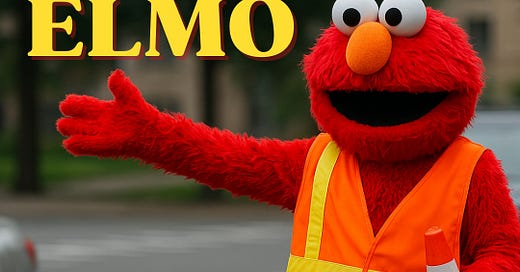Last week, I joined a group working through the ORSC (Organizational and Relationship Systems Coaching) modules. At one point, we were in the middle of a long, winding conversation, and someone calmly said, “ELMO.”
Not the furry red one exactly. Though in this case, it was a real, stuffed Elmo doll sitting nearby. The group smiled, and without much more, the conversation shifted. They had this shared practice. ELMO stands for “Enough, Let’s Move On.”
It’s funny, but it works. ELMO helps the group self-regulate. When someone sees the energy drop or the group drifting into over-analysis, they gently raise Elmo. It’s not confrontational. It’s just a nudge. Time to get back to the point. Back to the goal.
It got me thinking.
How teams get stuck
Teams don’t always get lost in the big picture. More often, they get stuck in the details. One or two people start exploring edge cases or diving deep into a rabbit hole. Others might check out. The focus drifts. Time gets used up.
In behavioral psychology, this is called attentional narrowing. When we focus too much on one thing, we stop processing everything else. In group settings, this can get contagious. One person’s deep dive becomes the team’s detour.
And this isn’t just about bad facilitation or poor agenda-setting. Even good teams drift. Especially high-performing ones. Why? Because deep thinking feels productive. But without guardrails, it eats up time that should be spent moving forward.
Why small nudges matter
Research from behavioral economist Richard Thaler (who helped develop the concept of “nudging”) shows that small prompts or signals can guide better group behavior without forcing it. That’s what ELMO does. It doesn’t shut people down. It just reminds the group of the bigger goal.
And there's something else going on. Using a shared term like “ELMO” gives everyone permission. You don’t need to confront or escalate. You just say the word. The group knows what it means.
This works because of how our brains process social norms. A cue like ELMO becomes part of the team’s micro-culture. It’s a shared agreement that it’s okay to move on, even if someone isn’t done talking yet. That’s powerful.
Teams need help staying in flow
In some ways, this ties back to something deeper in team performance: staying in flow. Not the individual kind that Mihaly Csikszentmihalyi wrote about. But team flow. That moment when there’s shared focus, energy, and clarity.
Team flow doesn’t happen when every voice is heard endlessly. It happens when there’s rhythm. Momentum. Trust that the key stuff will get addressed and that we’ll move forward together.
In that sense, ELMO isn’t a way to skip depth. It’s a way to protect focus. It keeps the team from getting lost in too many side conversations.
And honestly, how many meetings have you been in where ten minutes could have been saved with a simple, “Enough, let’s move on”?
Try it with your team
You don’t need a doll (though it helps). You can use an emoji, a card, or just say it out loud. But it works better when it’s agreed upfront. That this is how we’ll help each other stay on track. That anyone can say it. And that it’s not personal.
You might be surprised how quickly it becomes a part of your team's language. And how much time and energy it saves.
Want to go deeper? Start watching when your team loses energy in meetings. Notice when conversations start looping. Then, introduce the idea of ELMO. Frame it not as control, but as care. A way to keep each other out of the weeds and focused on the work that matters.
Let me know if you try it.




